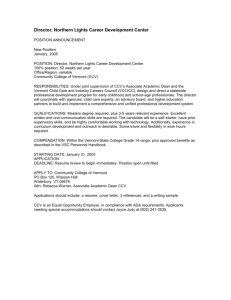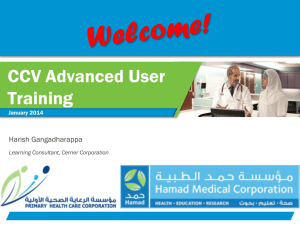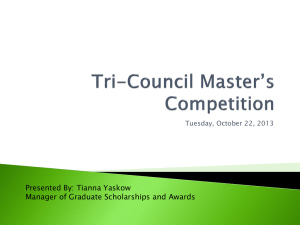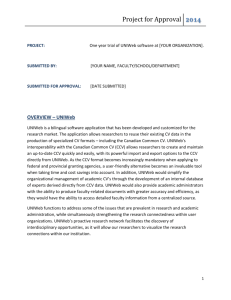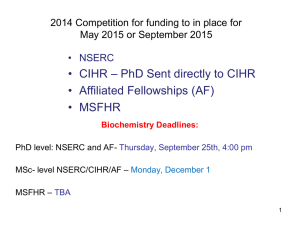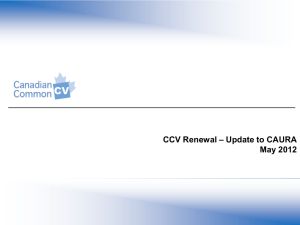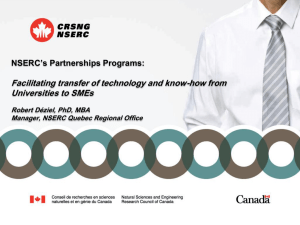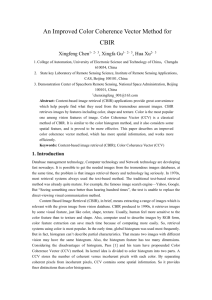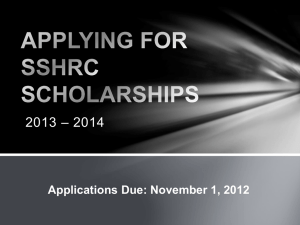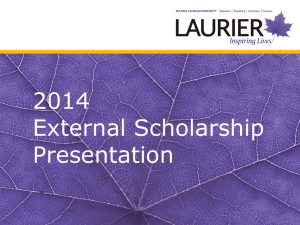CIHR
advertisement
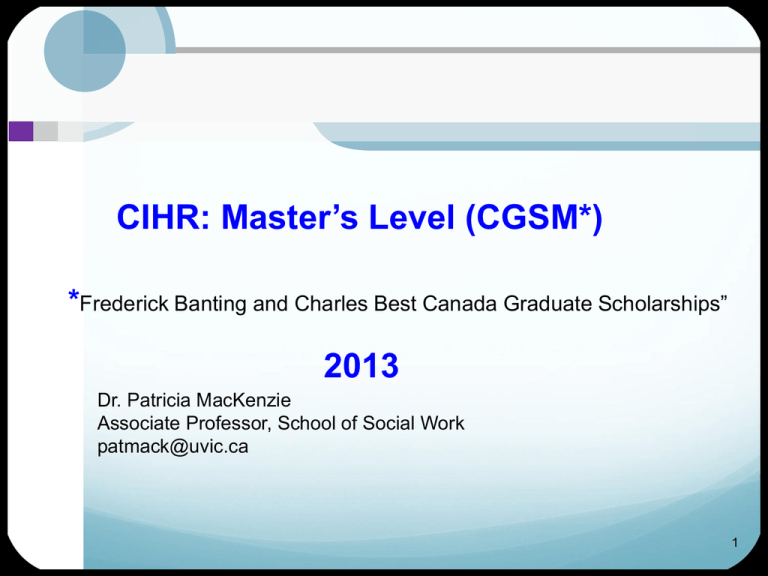
CIHR: Master’s Level (CGSM*) *Frederick Banting and Charles Best Canada Graduate Scholarships” 2013 Dr. Patricia MacKenzie Associate Professor, School of Social Work patmack@uvic.ca 1 CIHR Funding is for: all areas of health research, including biomedical, clinical, health services and policy, and social, cultural, environmental and population health. GOAL – The Canada Graduate Scholarships Master's Awards are intended to provide special recognition and support to students who are pursuing a Master's degree in a health related field at a Canadian institution. These candidates are expected to have an exceptionally high potential for future research achievement and productivity. 2 Changes for 2013 The new “Harmonization” process. There is now one application for the CGS-M for all three councils: • Social Science and Humanities Research Council (SSHRC) • Natural Sciences and Engineering Research Council (NSERC) • Canadian Institutes of Health Research (CIHR) The total amount available for this funding opportunity is $7M, enough to fund approximately 400 awards. Trainee stipend: $17,500 per annum. Awards must be held at the university where the offer of award originates. Awards are not intended to be portable between universities; however exceptions may be made in extenuating circumstances at the discretion of the host university, according to the academic and administrative regulations of the host university. 3 Which Tri-Council? General Guidelines for the Eligibility of Subject Matter at SSHRC Applications to SSHRC as the primary source of research or research training support must meet the following criteria: The program of research must be primarily in the social sciences and humanities (i.e., aligned with the SSHRC mandate and; The intended outcome of the research must primarily be to add to our understanding and knowledge of individuals, groups, and societies - what we think, how we live and how we interact with each other and the world around us. General Guidelines for the Eligibility of Subject Matter at NSERC Applications to NSERC as the primary source of research or research training support must meet the following criteria: The program of research must be primarily in the natural sciences and engineering; The intended objectives of the research must be, primarily, to advance knowledge in one of the natural sciences or in engineering. General Guidelines for Eligibility of Subject Matter at CIHR Applications to CIHR as the primary source of research or research training support must meet the following criterion: The intended outcomes of the research must, as stated in CIHR’s mandate, primarily improve or have an impact on health and/or produce more effective health services and products and/or strengthen the Canadian health care system. 4 In the past applications could be declined based on subject matter eligibility if a student applied to the “wrong” Council;…… In the harmonized system “every complete application will be reviewed and any questions about subject matter eligibility will be resolved by the university”. This means that: Every application will find a home and the application will be considered by the relevant Council. 5 Eligibility To be eligible to apply, you must: 1. be a Canadian citizen or a permanent resident of Canada; 2. Be enrolled in, or intend to apply for full-time admission* to an eligible graduate program at a Canadian university with a CGS M allocation; 3.Usually, have completed, as of December 31 of the year of application, between zero and 12 months of full-time studies (or full-time equivalent) in the master’s program for which you are requesting funding. Other regulations state that not have previously held a CGS M; have achieved a first-class average, as determined by the host university, in the last two completed years of study (full-time equivalent); and submit a maximum of one CGS M application per year (the Research Portal will allow the application to be submitted to up to five universities 6 Your graduate program must have a significant research component. A significant research component is considered to be original, autonomous research that leads to the completion of a thesis, major research project, dissertation, scholarly publication, performance, recital and/or exhibit that is merit/expert reviewed at the institutional level as a requirement for completion of the program. Master’s programs that are based only on course work are not eligible since they do not include a significant research component. 7 8 Application process The application is done electronically through the Research Portal which is accessed on the NSERC site, www.nserc.gc.ca In addition to the application students must complete the Canada Graduate Scholarship – Masters Canadian Common CV (CGS-M CCV) which you will be required to upload as part of your application 9 Identifying your Field of Research Previously, students applied to a specific Tri-Council…… now you will be asked to identify your area of research: health related, natural sciences and/or engineering, or social sciences and/or humanities Additional questions will be triggered based on your selection. For example if you select health research, you will be prompted to answer related questions e.g. Does the research involve human research participants? 10 Canadian Common CV (CGSM – CCV) A simplified version of the CCV for Masters Applicants has been created and instructions for creating it are available through the NSERC website at: http://www.nserc-crsng.gc.ca/Students-Etudiants/PG-CS/CGSMBESCM_eng.asp TIPS •Before you begin creating your CGSM CCV read through the instructions; you may also want to print them or have them available on another tab as you complete the CGSM CCV •Your CGSM CCV is intended to be a progressive document that you can add information to as you progress through your education and into your career. 11 The Common CV cont’d There are sections of the CGS-M CCV that will not relate to you at this point in your education and career so you will not need to complete them, but take time to check each section to be sure there is nothing you need to add As you work through each section, you will see either a red X, or a green √ - red X meaning something is missing and green √ indicating the section is complete As you complete each section, Add it to your CCV and click Done (you may need to click Done twice) 12 More on the Common CV When your CGS-M CCV is complete, click Submit the system will create a PDF and an .xml version of your CGS-M CCV and your confirmation number will be provided onscreen Click History in the top menu bar, and the Submission History will appear, click the .xml icon A download will appear and you will be prompted to Save File, so you can save a copy of the .xml file on your computer and you may rename it Take note of the file name of your CGS-M CCV so you can easily retrieve it when prompted to upload it to your CGS-M Application CAUTION: Don’t forget your password – waiting for a new temporary password when your may be under pressure to complete your application is a frustration you want to avoid (also avoided by applying early) If you have technical difficulties there is a Help option on the CCV main page, or you may email to webapp@nserc-crsng.gc.ca or call 613-995-4273. Include in your message the e-mail address and telephone number where you may be contacted. 13 Applying for the Canada Graduate Scholarship Masters (CGS-M) Students apply through the Research Portal which is accessed via the NSERC website at http://www.nserc-crsng.gc.ca/Students-Etudiants/PG-CS/CGSM-BESCM_eng.asp Presentation Standards for the CGS-M application You will be responsible for submitting an application that conforms the to following presentation standards (this will be available online): Text must be single-spaced, with no more than six lines per inch. •The acceptable font is Times New Roman (regular, minimum 12-pt.) or any comparable serif font. Condensed type is not acceptable. •Set margins at a minimum of 2 cm (3/4 of an inch) all around. •Use a left-justified, standard page layout. •Include your name in the page header (on every page). 15 • For multipage attachments, number the pages sequentially. • The maximum number of pages permitted is indicated in each section of the application. Pages in excess of the number permitted will be removed. • If you have supporting documents written in a language other than English or French, you must provide a translation of the document in English or French. • All attachments must be in PDF format before they can be attached to the electronic application. NOTE “Incomplete applications will be rejected, and applications that do not meet presentation standards may be rejected or at a disadvantage,” 16 17 Provide a Clear Outline of Your Proposed Research NOTE: The instructions indicate that you have one page maximum for your research proposal and one page for citations; don’t be confused by the text on the application which might seem like you have two pages for your research proposal 18 19 The details follow instructions exactly adhere to format guidelines (e.g., font, page limits) applications MUST be completed using the media specified in the funding opportunity use the full page allowances familiarize yourself with the Guide for Reviewers start several weeks before the deadline – right now! Working with your UVic Grantscrafter • Not a guarantee that you will get the grant! • Application material, ideas and discussion will remain confidential • Positive criticism • Technicalities not addressed 21 Context and Support Matters! work on the research proposal and the full application in collaboration with your supervisor/mentor proofread your application … carefully! show the complete application to their supervisor/mentor, peers and other researchers for feedback Be prepared to produce multiple drafts If you can, set up an internal review system – other students who have been successful, other applicants, profs, etc. Even if not successful you will produce a draft of your thesis proposal so think positive Do not wait to submit until the last minute Planning for Success Grades matter! Sponsor Letters are very, very important – choose wisely Emphasize publications, research experience, professional experience A strong training environment where you will get exposure to research and have research networking and mentoring opportunities is essential The “Narrative” • A well-laid out proposal says to a committee “this person knows what they are talking about and they have taken as much care with their proposal as we are now doing.” • Reviewers are busy people and have many proposals to read. Make yours one they will want to read! • Ensure you convey what you are proposing is relevant, unique, and will benefit the health of Canadians 24 Think about the ‘audience’ • Assessors may have the kind of specialized knowledge you need, but a committee will not. • Provide a rapid introduction for intelligent non-specialists. • Provide appropriate (and recent!) references. 25 Provide Information Clearly • Committees are not only not infallible and tired, they are also starting with imperfect information about you and your institution. • Give them the information you know is essential to your case, straightforwardly and succinctly. 26 Logical and Connected Proposal • Present research plans coherently, as a set of problems. • In a logical and connected order. • Always state the central problem of your work and why it is important. 27 Critiques • If you are critiquing existing models or approaches in the literature, • do so lucidly, without partisanship, and • demonstrate clearly why your approach is better. • Be precise. 28 Adjudication Committees • Most of these committees are interdisciplinary; some are not; some have non-academics on them. They are your audience – write to them. • Committees get tired and impatient with complex obscure language, typos, poorly laid-out proposals with grammar and spelling errors, and incomplete information. 29 Review Procedures The Faculty of Graduate Studies (or equivalent) at each Canadian university is responsible for coordinating the selection process for the CGS M applications, and for communicating the results to the applicants and agencies. The university selection committees evaluate each CGS M application. The UVic allotment is 6. 30 Selection Criteria Academic Achievement - 50% Research Potential - 30% Personal Characteristics and Interpersonal Skills 20% 31 Peer ‘preview’ • Ask a friend who is not overly familiar with your research to read your proposal some day/evening when he/she is tired and see if it makes sense. • Then ask your friend to tell you which bits are confusing, or that had to be read twice. • Then sit down again and work on getting rid of the jargon, or the long sentences, or . . . 32 Final Observations • Grant competitions are still going to be, on occasion, unfair. • After one rejection, do not despair. . . or at least, not for long. • There will be comments that come with the decision. • Take the advice that makes sense to you; ponder the rest, and then accept or reject it. 33 Summary Five Steps Get going on the Common CV Find your Referees and get them committed Assemble your application Submit your application Await notification of decision 34 Where to now? How do I remember all this information? All the information presented today will be available on the Faculty of Graduate Studies website under External awards and fellowships http://www.uvic.ca/graduatestudies/finances/financialaid/externalawar ds/ Questions about the CGS-M Application or Masters CCV process?? Faculty of Graduate Studies Scholarship Officers: Kathy McCarthy fgsaward@uvic.ca Yvonne Rondeau scholoff@uvic.ca 35 Contact Info Dr. Patricia MacKenzie patmack@uvic.ca 250-721-8735 36 Thank You Questions? 37

